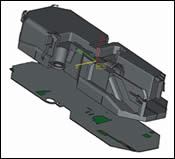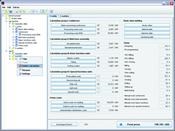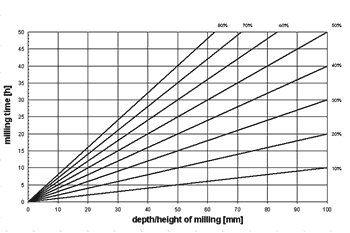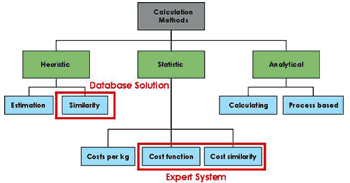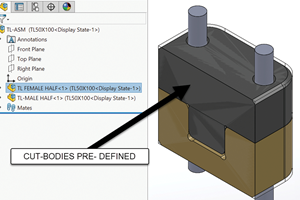Competitiveness by Systematic Mold Pricing
Moldmakers and mold buyers can gain many advantages from using a structured mold pricing solution.
The machinery and tools for the design and production of molds and tools undergo steady development. Many innovations are coming across in connection with milling, EDM and CAE software, but there is one side of the moldmaking process that isn’t very innovative: mold pricing.
Mold pricing, in the most cases, is done like it was decades earlier. Moldmakers use their experience and expertise and often “guess” the price with varying success. Surveys show that still about 75 percent of all moldmakers are calculating on that basis, which inevitably leads to big differences in mold pricing.
Mold buyers have another approach to mold price estimation. They send dozens of requests for quotations to their mold suppliers inundating those responsible for moldmaking calculation. This results in a lot of highly skilled workers using 80 to 90 percent of their time making quotations for projects that never turn into business.
Two factors are mainly responsible for this mold pricing prob-lem: (1) new opportunities and developments in mold manufacturing have resulted in mold designs that are more and more complex, making it difficult to judge them in terms of mold costs; and, (2) increasing international competition in moldmaking has required that a detailed calculation of mold costs be completed at an early stage of a project.
The OEMs—not only in the automotive sector—ask for cost breakdowns in the calculations, and although only a small percentage of the quotations become orders, every calculation must be detailed in order to be competitive.
Both sides, moldmakers and mold buyers, face the same problem: a huge amount of quotations resulting in time and accuracy issues. Numerous tests have shown that the quotations for a mold can vary by more than 100 percent under the same circumstances (region, information, hourly rates).
The problems for the person in charge of mold calculation—no matter if on the side of the moldmaker or the mold buyer—are always similar:
- Due to the amount of calculations to be made there is no time left to proceed with the necessary accuracy.
- There always are several different possibilities when it comes to building a mold and the design of these molds has a high level of influence on quality and price.
- Calculation for similar molds from older quotations are often taken without having post-calculated them (database solution).
- Customer requirements are not considered.
- If individual mold features are not clear, “arbitrary surcharges” result.
Systematic Approach to Mold Pricing Required
In order to deal with this mold pricing issue, requirement tools are needed for a systematic, fast and consistent procedure for mold cost calculation. Pre-calculation software (pricing software) can be the key to solving this problem.
Currently, there are different kinds of software for pricing injection molds, pressure-die casting molds and stamping tools, but these software tools have different approaches—coming either from the technical or organizational (business) side.
By using a structured pricing solution, moldmakers and mold buyers can gain a lot of advantages.
- The calculation result is not only dependent on the experience of the calculator.
- Calculation results can be understood and shared by everybody.
- Nothing is forgotten (checklist).
- Process steps are distinct and can be used not only for the overall costs, but also for the required cost breakdown and work scheduling.
Database Versus Expert System
There are two pricing solution systems (see Figure 1): database systems and expert systems. The database system involves searching a database of past and similar projects (molds or parts) to relate them to the current request. These systems can be very powerful and accurate—especially if the parts are always similar in terms of shape and complexity.
To develop a database system requires a lot of data from the tool shop (post-calculation of molds, which involves the calculation of the mold cost after the mold is finished based on the real values from the tool shop). This information has to be fed into a database in order to get accurate results; company data collection. This system can only work if the manufacturing hours and prices for the previous jobs are correct.
Another possibility is the expert system in which the experiences from former projects are not used directly for the pricing of new molds. The data collected is evaluated by the developer of the expert system in order to define cost similarities and cost functions. In an expert system the user does not have to do any initial work (formulas, data, etc.). The developer of the expert system is the company or person who is developing the expert system solution. Different steps in the process chain of mold production are investigated in detail—all of the steps that lead to a mold are examined like milling, EDM, manual work, etc.; the examination leads to the algorithms that are necessarry to calculate the mold costs. The result is that functions can be defined which, for example, determine the setup time of a cavity plate based on its weight. In expert systems each mold is calculated as a completely new mold.
The manufacturing times can be cal-culated using cost similarities (basic times) represented in diagrams and formulas (see Figure 2). These have to be evaluated by tryouts and an investigation of existing manufacturing data. Having this manufacturing data makes it possible to perform a regression analysis (creating a curve only from some single points in a diagram, which leads to a curve that can be formulated in a mathematical way) that leads to diagrams (curves) like the one shown in Figure 2 depending on the considered kind of manufacturing process.
The basic times have to be multiplied with several factors to refine the calculated times. These factors represent the influences on manufacturing time. For example, in the case of basic time for milling (tFr) some factors include: surface quality (COG), dimensional quality (CMT), used material (C1, C2), etc. In the end the finally calculated manufacturing time can be multiplied with the hourly rate of the corresponding machine (SML).
The process of data collection for the definition of these formulas and diagrams is very time-consuming. Once the functions and diagrams are defined and become part of the pricing software, mold costs can be calculated in a very easy and accurate way.
Theoretically, it is possible to use the formulas of the existing expert systems for the calculation of mold costs manually without software support, but using software is a much better solution. Computer-aided calculation (CAC) is a very obvious and reasonable method for meeting today’s requirements for mold pricing. Figure 3 shows an overview and the degree of detail that is possible in today’s pricing solutions.
The advantages in using an expert system are:
- No time-consuming development necessary (plug and calculate)
- Programming work is done by experts
- No time-consuming maintenance is necessary
- Same calculation platform for all par-ticipants (mold buyers and moldmakers)
- Well structured and documented mold calculations in a short time are possible
Using 3-D Analysis for the Calculation
Another interesting aspect is the direct use and processing of 3-D data for the calculation. As parts become more and more complex, only the 3-D file allows for a quick judgement about the cost drivers in a mold (e.g., detecting undercuts and potential areas for EDM). The interface to the calculation system (the software solutions that enable an analysis of 3-D files are always separated from calculation software; therefore, the link (interface) between 3-D software and calculation software has to be made) helps create sliders, cores and EDM electrodes automatically (see Figure 4).
However, even if a ready-to-use (plug and calculate) solution is implemented, there is still a need for moldmaking expertise. Additionally, this pricing system must be accepted by everyone within the company for it to be used successfully to submit competitive and accurate quotations.
Economical Factors
Most of today’s pricing solutions provide manufacturing times and material costs, but that is only one aspect of calculating the final quotation price. The “technically” based part of the mold price is now being multiplied with the economic side (such as hourly rates of machines, relationship between moldmaker and buyer, etc.) and, the calculated manufacturing times now have to be multiplied with the hourly rates for the different kinds of machinery used in moldmaking, the company overhead and the profits.
The overhead is influenced by many factors, such as the degree of efficiency in the tool shop, customer relationships, use of special technology and quality. Additionally, pricing calculations differ if part production also takes place in the shop.
Because hourly rates are more frequently determined by the mold buyers or competitors, a systematic calculation can be helpful. By having all the manufacturing times calculated, it is easier to define the minimum price that has to be achieved for a mold without subsidizing the project.
Conclusion
The experiences with pricing software are different because every company that calculates mold prices has a different approach and philosophy. Therefore, a more or less fixed solution (a solution that is not possible to customize; current software solutions for mold pricing are quite inflexible and calculation software has to meet the requirements of all users) is difficult to apply. As the development of pricing tools continues, this situation will improve.
Today it is possible to calculate mold costs by describing only the geometry and features of the injection molded part. Three-dimensional data can be used for the description of the part geometry, and in the near future it will be possible to make a mold calculation based solely on 3-D files.
The importance of a detailed calculation in the early stages of development is already widely accepted, making the need stronger for calculation software that aims to support the pricing step.
Related Content
How to Analyze and Optimize Cutting Conditions to Reduce Cycle Time
Plastic injection mold design and manufacturing company puts NC program optimization software module to the test. The results were surprising.
Read MoreTake Time to Save Time: 6 Steps in Mold Design to Reduce Back-End Troubleshooting
Westminster Tool shares how the one week it typically takes to perform these six steps in the design phase can save three weeks or more in an overall tool build.
Read MoreHow to Use Scientific Maintenance for More Accurate Mold and Part Troubleshooting
Discover how adopting scientific maintenance approaches helps improve mold lifespan, minimize failures, and optimize production outcomes.
Read MoreRead Next
How to Determine the True Cost of Your Molds
When considering the purchase of a mold, the wrong question is "What is the price of this mold?" The right question is "What is the total cost-to-manufacture for this product?"
Read MoreAre You a Moldmaker Considering 3D Printing? Consider the 3D Printing Workshop at NPE2024
Presentations will cover 3D printing for mold tooling, material innovation, product development, bridge production and full-scale, high-volume additive manufacturing.
Read MoreReasons to Use Fiber Lasers for Mold Cleaning
Fiber lasers offer a simplicity, speed, control and portability, minimizing mold cleaning risks.
Read More



